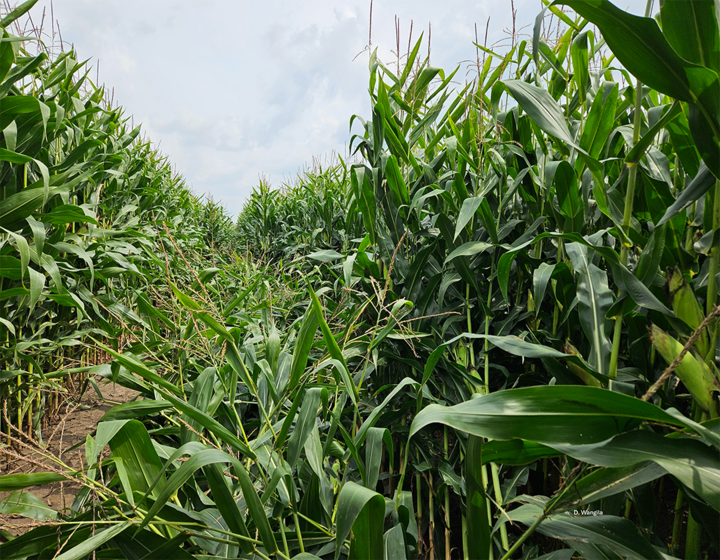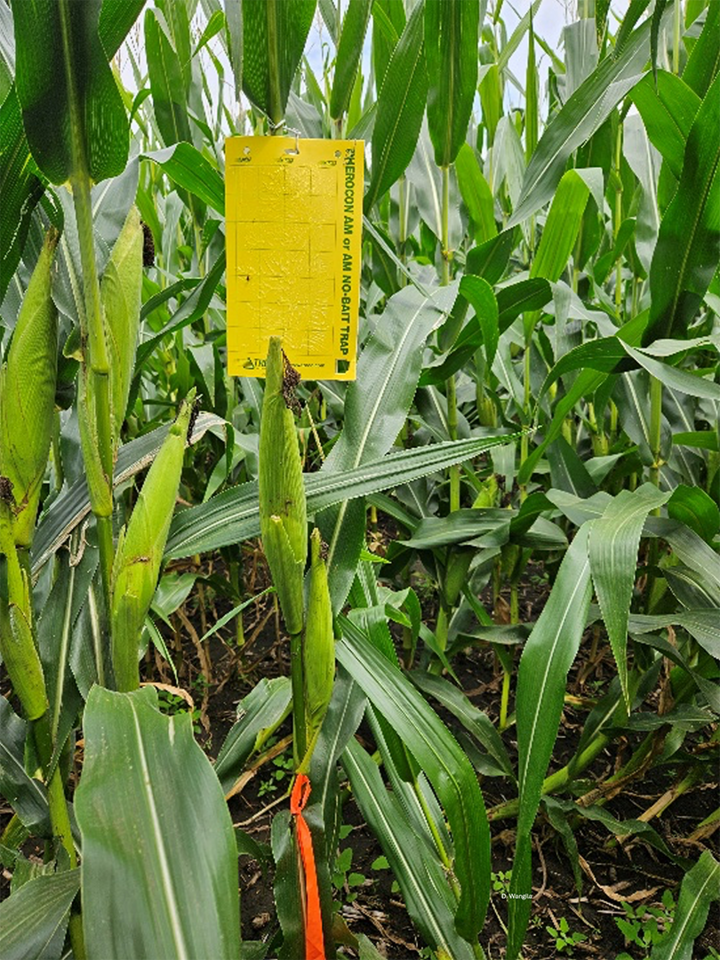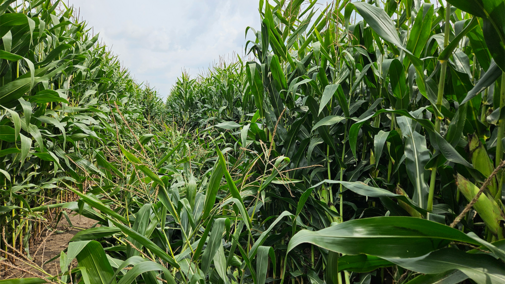Key Takeaways
Adult beetles are soon emerging and can cause damage to silks. Females lay eggs that will hatch next year and cause injury to corn roots.
Scouting for adult corn rootworm provides handy data required for making integrated pest management decisions.
Scouting should begin in early to mid-July and continue through August.
Recent UNL research shows Bt-resistant beetles can move into first-year cornfields, reinforcing the need for all fields to be scouted — not just continuous corn.
Corn rootworms are the most economically important pest of corn in the United States, causing close to $2.0 billion in yield loss and cost of management each year. At this point in summer, much of larval feeding on corn roots is done and adult corn rootworms are soon emerging; however, it’s not too late to begin or intensify management efforts targeting corn rootworm beetles. With proper scouting, informed interpretation of field-specific data and integrated pest management strategies, farmers can take meaningful actions now to mitigate risks during corn tasseling, and for next year’s crop.
Life Cycle and Movement
Corn rootworms have one generation per year, with the most economically important stage being the larvae. In Nebraska, adults begin emerging from mid-July to mid-August and live for up to six weeks. Adult emergence timing is mostly predicted using degree-day (DD) accumulation, with 5% emergence occurring at approximately 1,400 –1,500 DD (base 52°F). Nevertheless, emergence can vary based on soil type, planting date, larval population and exposure to Bt toxins or insecticides.
Once emerged, females mate and can lay more than 1,000 eggs, with the majority oviposited in August and September. These eggs overwinter in cornfields and hatch the following spring (late May to mid-June), creating localized infestations. Adult dispersal is limited to an estimated 130 feet per day — thus the need for field-level scouting and management decisions.
Scouting for Corn Rootworm: When and How
Scouting is a cornerstone of effective management and should begin around the R1 growth stage (silking), typically by early to mid-July, and continue through August. Early detection of populations/root injury reaching economic threshold provides valuable insights for devising appropriate management strategies. The key scouting techniques include digging roots to check for larval injury, the use of sticky traps to monitor adult density and whole plant counts.
Check for Root Injury

This is ideally done when you see adult rootworms in an area within the corn field. In some cases, this may also be associated with plant lodging, especially during strong winds (Figure 1). Dig out some plants with an entire root system, wash and assess root injury using the Iowa State University, 0 to 3 Node Injury Scale (NIS).
To rate corn rootworm injury, evaluate nodes 4-6 — the three nodes closest to the soil surface. For each of these nodes, count the number of roots pruned within 1.5 inches of the stalk and divide this by the total number of roots on that node. The final root rating is the sum of these individual node ratings. A rating of 0.25 signifies the economic injury level, indicating a potential yield loss.
For more information on the NIS, check this article.
Sticky Traps
Position unbaited traps (e.g., Pherocon AM) at ear height at least 100 feet away from the field edges and at least 100 feet from trap to trap and placed in a “W” format to gain a representative sample of the field. We recommend checking, recovering and replacing traps with new traps once per week all through the six-week period from the time of first beetles are noted in the field. A threshold of >2 beetles/trap/day suggests that changes in management — such as switching hybrids, rotating crops or using soil insecticides — may be necessary the following year. See Figure 2 for placement of the sticky traps.

Whole-plant Counts
We recommend that you randomly sample 50 plants in each field using an "M" or "W" pattern by checking the plant from tassels to the lower parts of the stalk. The plants should be at least 100 feet away from each other. If the average beetle count reaches ≥1 beetle per plant, the risk of yield impact or egg-laying for next year increases.
Scouting should prioritize fields with silking corn, as adult beetles are attracted to corn at this stage, to feed on pollen and silk. Fields in the vegetative stage or post-pollination are less attractive and may not yield accurate population assessments.
Details on whole plant thresholds can be found here.
Recent Findings: Resistance Concerns in First-year Corn
A recent study by UNL entomologists in northeast Nebraska sheds light on our understanding of corn rootworm dynamics within fields. The study found that Bt-resistant western corn rootworm populations immigrated into first-year maize fields from nearby continuous cornfields. Using weekly trap data and bioassays, researchers confirmed that first-year fields are no longer immune to rootworm pressure, especially when other infested fields are nearby. This reinforces the necessity of monitoring all cornfields — not just those in second or third-year corn — and incorporating integrated pest management tactics for management of corn rootworm.
Integrated Pest Management Strategies
1. Crop rotation: Planting non-host crops like soybeans after a year or two of planting corn remains one of the most effective tools against corn rootworm. Crop rotation interrupts the rootworm life cycle as corn rootworm larvae starve and die during the non-host crop planting. The only drawback to this strategy is the occurrence of rotation-resistant corn rootworm variants, which lay eggs in soybean fields. However, these variants are not present in fields across Nebraska, making crop rotation a great tool to manage this insect pest.
2. Bt Corn Hybrids: Transgenic Bt corn technologies targeting corn rootworm have been available in the U.S. since 2003. Hybrids expressing multiple Bt toxins (pyramided traits) are available and widely adopted by farmers. Corn rootworm resistance to Bt is a growing concern. To delay resistance, consider rotating Bt technologies, adopt crop rotation and adopt adult mitigation measures, if required. The Bt traits handy table is found here.
3. Insecticides: Foliar sprays target adult beetles to reduce silk clipping and suppress egg laying and associated number of larvae the next season. Apply when adult counts exceed thresholds (mentioned earlier) but avoid unnecessary applications that may accelerate insecticide resistance. However, studies have shown that complexities in timing of spraying plus number of foliar sprays required for adult control makes this practice not economically viable. For next year, consider using soil applied insecticides at planting to protect corn roots from larval feeding and injury if the current population has shown possible damage the next year.
It’s Not Too Late
Although the window for larval control has passed, adult beetle monitoring is now crucial. Fields with silking corn should be actively scouted. High adult populations observed in July and August can signal elevated risk for root injury in 2026. We strongly recommend scouting of all corn fields, including first-year corn, to match appropriate corn rootworm management approaches to relative risk.
Taking time to scout now provides you with data-driven decisions for the following growing season. Nebraska corn growers still have time to better manage corn rootworm, now and for next year, so don’t wait. Scout now, manage smart, and plan for 2026!
Resources
- UNL CropWatch - Corn rootworm management, Dig corn roots to evaluate management
- McCulloch, J. B. & Gassmann, A. J. (2024). Effects of combining soil-applied insecticide and Bt corn for integrated pest management and resistance management of western corn rootworm (Coleoptera: Chrysomelidae).
- Meinke, L. J., et al. (2025). Western corn rootworm adult activity and immigrant resistance to Bt traits in first-year maize.

